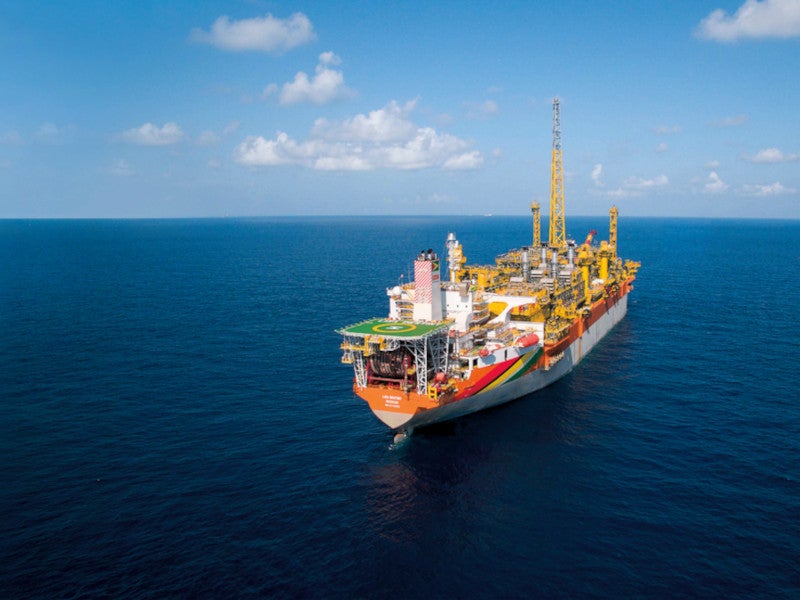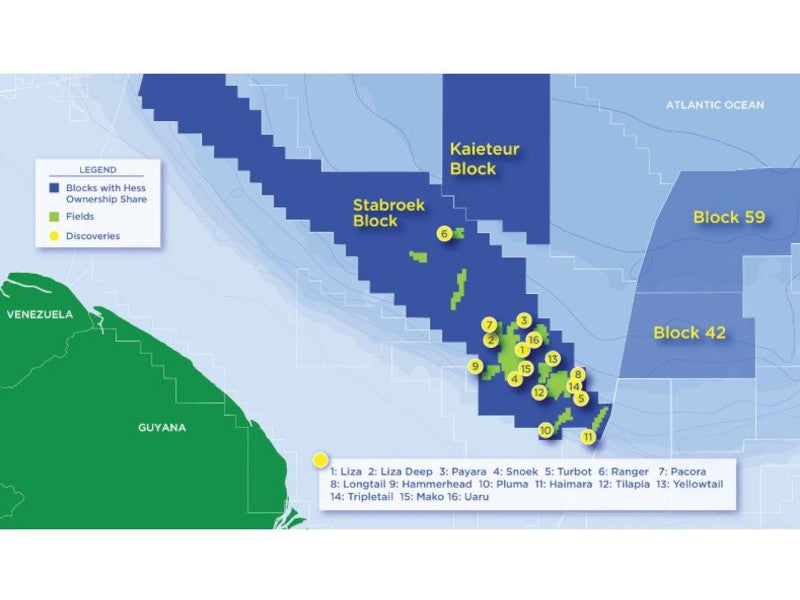The Yellowtail development project is located in the Stabroek Block, 202.77km offshore Guyana. It involves the development of the Yellowtail and Redtail fields.
The Stabroek Block is operated by ExxonMobil’s subsidiary Esso Exploration and Production Guyana (EEPGL) with 45% interest. Hess Guyana Exploration and CNOOC Petroleum Guyana are the other partners in the block, with interests of 30% and 25%, respectively.
The environmental impact assessment (EIA) report of the Yellowtail project was submitted to the Environmental Protection Agency (EPA) of Guyana in October 2021, as required under the approval process. The EPA commenced the review of the EIA in November 2021.
ExxonMobil made the final investment decision (FID) on the project in April 2022, after securing environmental approval from the EPA. Production is scheduled to commence in 2025, with an estimated investment of $10bn. The project is expected to generate approximately 1,300 jobs across four phases.
Location
The Yellowtail and Redtail fields lie in the Stabroek Block, which covers an area of 6.6 million acres (26,800km²). The Stabroek Block holds an estimated recoverable resource of more than ten billion oil-equivalent barrels.
The block comprises several major discoveries, including Liza, Liza Deep, Payara, Yellowtail, Tripletail, Snoek, Hammerhead, Ranger, Pacora, Longtail, Turbot, Whiptail, Pluma, Tilapia, Haimara and Mako. The discoveries are expected to lead to at least ten development projects in the block as well as the installation of up to ten floating production storage and offloading (FPSO) vessels, with six FPSOs expected to be online by 2027.
The Yellowtail project is EEPGL’s fourth approved project in the block, following the Liza Phase One, Liza Phase Two and Payara projects.
Yellowtail and Redtail discovery details
Yellowtail was the 13th oil discovery in the Stabroek Block, while Redtail was the 18th. Yellowtail was discovered in April 2019 by the Yellowtail-1 exploration well drilled by the Noble Tom Madden drillship. The well was drilled to a depth of 18,445ft (5,622m) at a water depth of 6,046ft (1,843m) and intercepted approximately 292ft (89m) of a high-quality oil-bearing sandstone reservoir.
The Yellowtail-2 appraisal well was drilled by the Stena Carron drilling rig in July 2020 to assess the Yellowtail discovery. The well intercepted a net pay of 69ft (21m) in additional high-quality oil-bearing reservoirs located next to and below the Yellowtail-1 discovery.
Redtail was discovered in August 2020 with the drilling of the Redtail-1 exploration well by the Noble Don Taylor drillship. Located 2.5km north-west of the Yellowtail discovery, the well encountered approximately 232ft (70m) of high-quality oil-bearing sandstone reservoir at a water depth of 6,164ft (1,878m).
Yellowtail development details
The development plan for the Yellowtail project includes six drill centres and the drilling of between 45 and 55 development wells, including 26 production and 25 injection wells that will be tied back to the ONE GUYANA FPSO vessel for processing.
A subsea umbilical risers and flowlines (SURF) production system comprising 51 enhanced vertical deepwater trees (EVDT) with associated tooling, as well as 12 manifolds with related controls and tie-in equipment, will also be installed for the project. Oil tankers will be used to transport and export the produced oil from the field to global markets.
ONE GUYANA FPSO details
The ONE GUYANA FPSO will be SBM Offshore’s sixth newbuild to feature a multi-purpose floater hull. Based on SBM Offshore’s Fast4Ward® programme, the vessel incorporates advanced technologies along with standardised topsides modules. ONE GUYANA will be SBM Offshore’s fourth FPSO based on the programme, following the Liza Destiny, Liza Unity and Prosperity FPSOs in Guyana.
The FPSO will be spread moored by an up to 22-point spread mooring anchor system at a water depth of approximately 1,800m. It is estimated to have an optimum production capacity of 250,000 barrels per day (bpd) of oil. The vessel will have a storage capacity of two million barrels of crude oil, gas treatment capacity of 450 million ft³ a day, and water injection capacity of 300,000bpd.
The vessel will be designed to perform produced water treatment functions as well as oil separation and gas injection. It will include a flare tower, safety system and power generation capability, and crude metering system.
Contractors involved
TechnipFMC received a contract to supply the subsea production system for the project in November 2021.
SBM Offshore received the front-end engineering and design (FEED) contract for the FPSO vessel in November 2021. The company partnered with McDermott and created a special purpose company (SPC) to execute the FEED contract. SBM Offshore holds 70% equity ownership in the SPC while McDermott holds the remaining 30%.
SBM Offshore received the contract to construct, install, lease and operate the FPSO in April 2022, following the completion of the FEED studies. The company will operate the FPSO for up to two years, following which the ownership of the FPSO will be transferred to EEPGL.
Oilfield services company Saipem was awarded the engineering, procurement, construction and installation (EPCI) contract for the SURF system of the project in January 2022. Saipem will use its FDS2 vessel to install the SURF system, which will be fabricated at the company’s fabrication facility in Guyana.
Energy services provider Hunting was contracted to supply titanium stress joints for the project in April 2022.
Energy and infrastructure technology company Shawcor received a letter of intent (LoI) in April 2022 to provide coating services for the project. The company is expected to sign a formal contract later in the year.



